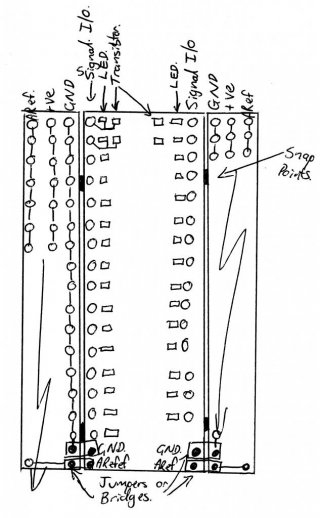Good Morning all.
Possibly setting myself up for a flaming, but here goes.
Love the Teensy and what it does, but it's so damn small (Yes I know, hence the Teensy name)
I'm pretty sure there would be a market for a more versatile version.
My thoughts are the following:
Similar format i.e: pins on three sides, but no surface mount connections on the bottom as in the current Teensys;
All IO pins on the outside;
One pin in for each IO,i.e.:2.54mm; (1)
The next pin in is a +V 5V (2)
The next pin GND (3)
If the pin is Analogue capable, the next pin is a Analogue AREF; (4)
The above format would allow direct connection of servos and easy connection to switches & potentiometers;
Eg: 1,3 is a switch or LED or PWM device.
1,3,4 is a potentiometer
An onboard LED for every pin, similar to that used on the current Pin13 (Don't know if that's possible, either hardware wise, but may just need an addition to coding). Allows for easier prototyping.
A higher current 3.3V, and 5V regulator to power outputs via transistors;
SMD Transistors and if required diodes to allow a greater overall output per channel attached to each output using the transistor to reduce current workload on the CPU;
DIP switches onboard to negate track cutting, such as VIN/VUSB;
The above would probably fit on a circuit board about double that of the current Teensy 3.X.
Personally I would think the above would be more versatile with only minimal increase in PCB realestate.
OK guys and gals, let the flaming (err, comments) begin.
Rob.
Possibly setting myself up for a flaming, but here goes.
Love the Teensy and what it does, but it's so damn small (Yes I know, hence the Teensy name)
I'm pretty sure there would be a market for a more versatile version.
My thoughts are the following:
Similar format i.e: pins on three sides, but no surface mount connections on the bottom as in the current Teensys;
All IO pins on the outside;
One pin in for each IO,i.e.:2.54mm; (1)
The next pin in is a +V 5V (2)
The next pin GND (3)
If the pin is Analogue capable, the next pin is a Analogue AREF; (4)
The above format would allow direct connection of servos and easy connection to switches & potentiometers;
Eg: 1,3 is a switch or LED or PWM device.
1,3,4 is a potentiometer
An onboard LED for every pin, similar to that used on the current Pin13 (Don't know if that's possible, either hardware wise, but may just need an addition to coding). Allows for easier prototyping.
A higher current 3.3V, and 5V regulator to power outputs via transistors;
SMD Transistors and if required diodes to allow a greater overall output per channel attached to each output using the transistor to reduce current workload on the CPU;
DIP switches onboard to negate track cutting, such as VIN/VUSB;
The above would probably fit on a circuit board about double that of the current Teensy 3.X.
Personally I would think the above would be more versatile with only minimal increase in PCB realestate.
OK guys and gals, let the flaming (err, comments) begin.
Rob.


